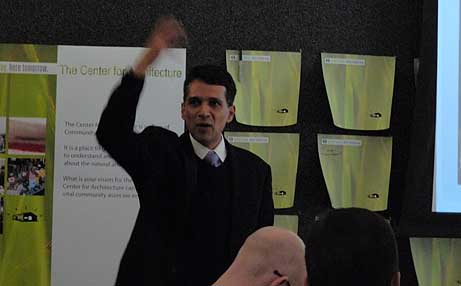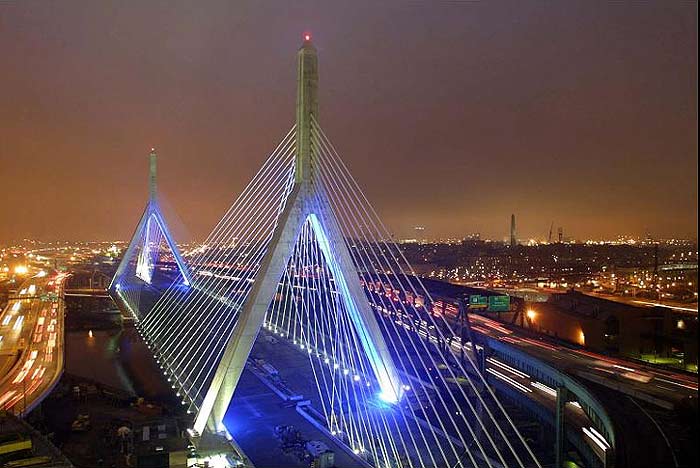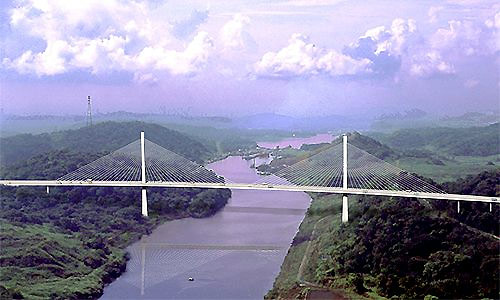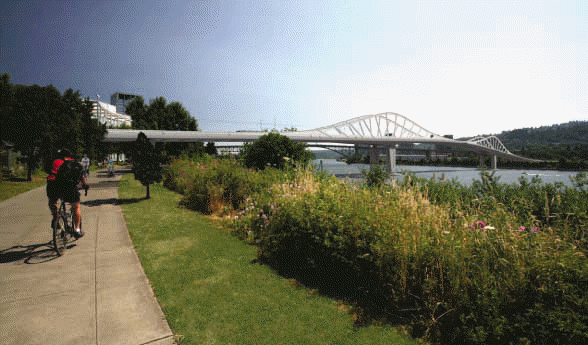
|
||
|
Portland art blog + news + exhibition reviews + galleries + contemporary northwest art
|
||
Reading between the bridges  Bridge architect Miguel Rosales @ AiA Portland Architect Miguel Rosales Urban Design Board presentation at AIA's Portland HQ's today was interesting... and it should be, it was about the new light rail and pedestrian bridge across the Willamette weve been following. The meeting wasn't about revealing anything new about the design or process, it was more of a "read between the lines" moment and getting a measure of the architect and project. Here's a PDF that details where we are now and covers most of the presentation today.  Zakim Bridge (cable stayed design) What came out "between the lines" was this: 1st priority is following all of the federal guidelines so Portland can get maximum federal $$$ for the project. Notably, Rosales is no stranger to big federally funded transit projects, his Leonard P. Zakim bridge in Boston was part of the Big Dig project (the largest single transit project in US history). Clearly he was chosen because he can deliver beautiful bridges and has the "taxpayer approved" track record. Rosales is a good architect but the opposite of a starchitect... his bridges are likely to be more famous than he is. This point is important because if someone like Calatrava were involved you would be assured the fed's wouldn't like it. If we wanted Calatrava we would have to pay for the entire project out of Portland's coffers and I think there is more chance for getting a starchitect for the I-5 bridge.  Centennial Bridge (Panama), the country wanted Rosales to do something spectacular Trimet was smart in its decision to blend design and costs, we need to pick our battles. In the case of I-5 the feds are the ones saying, "you gotta build a better bridge" and we can counter with we want something that goes beyond a mere bridge. In the case of the new Willamette crossing it is our city's expansion of light rail that is driving the process, it's us trying to convince the feds they need to support as much of it as possible. Still Rosales mere presence sets a higher design bar for the I-5 bridge project. 
a prelimenary wave frame bridge design for the Willamette Overall, the presentation was straight forward, and the preliminary designs he showed are just bridge types that are to be selected as style candidates. We knew that part already, but there is always the danger that "the preliminary" becomes what is eventually built. The second "read between the lines" moment came to light when someone asked a cost question regarding the 5 design possibilities. Earlier in the presentation Rosales indicated that all 5 of the designs presented cost about the same... well it turns out that is "sort of". It seems that the cable stayed designs were designed to be similar in cost to the other options... so does that mean somewhat cut rate design for the most towering bridge options?? I prefer design quality to size. Is that why the two cable stayed designs proposed seemed a tad clunky in comparison to other cable stayed designs by Rosales? Maybe it's just clunky in a preliminary design sense? Overall, I'm a big fan of cable stayed designs but they tend to be a little anonymous and I'd like to see the wave form bridge pushed a little farther. Rosales builds elegant bridges, not histrionic ones like this. He does have a showy side though, bridge lighting does seem like something Rosales excels at (it is not being discussed now, too early for that when structural decisions are the only thing on the table). The third "read between the lines" moment was when Rosales mentioned that it was interesting that Portland's Leanne Marshall won Project Runway... ie he wasn't aware that Portland is bristling with young designers, artists etc. Huh? I suppose Trimet neglected to tell him about that part. That "moment" was interesting because these new Portland aestheticians are now the current face of Portland and the bridge needs to reflect their design standards.... hence the reason PORT continues to cover this (BTW it's still a civic tragedy that the Oregonian still does not have an architecture/design critic... I realize it's out of the editor's hands but "the void" left by Randy Gragg is a needless embarrassment and a danger to Portland's highly prized civics and new found design standards). In the end, all of us who care about aesthetics (and function) need to voice our support for superior design on this bridge project as it seems like Rosales delivers bridges whose quality is tied directly to the wishes of those that use and make them happen. Conversely, a starchitect often bullies their clients into doing something brave (or stupid), whereas Rosales raises the bar by harnessing "aesthetic will", which can then be brought to bear onto the pragmatic necessities. In other words, the more public discourse and wrangling over design... the more likely we are to get an exceptional bridge. This is bridge city after all. *note: Rosales is also doing the pedestrian bridge at One Waterfront Place as well Posted by Jeff Jahn on October 28, 2008 at 21:52 | Comments (1) Comments Jeff Posted by: Charles Post a comment Thanks for signing in, . Now you can comment. (sign out)
(If you haven't left a comment here before, you may need to be approved by
the site owner before your comment will appear. Until then, it won't appear
on the entry. Thanks for waiting.)
|
| s p o n s o r s |
 |
 |
 |
 |
 |
 |
 |
 |
 |
 |
 |
 |
 |
 |
 |
 |

|
Site Design: Jennifer Armbrust | • | Site Development: Philippe Blanc & Katherine Bovee | |


![[TypeKey Profile Page]](http://www.portlandart.net/nav-commenters.gif)